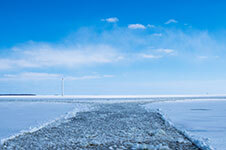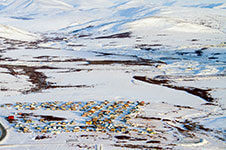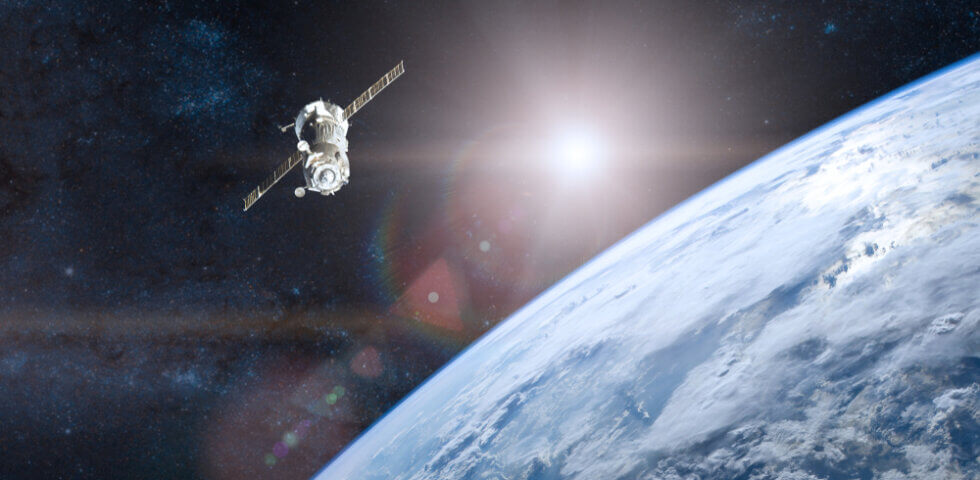In February of 2021, Quintillion officially finished the construction of its High-Latitude Data Acquisition (HiLDA) Ground Station. This satellite ground station was built as a downlinking facility for polar orbiting satellites (low earth orbiting satellites that pass the North and South Poles and orbit the Earth multiple times a day).
The facility was designed to accommodate future growth as an expansive, multi-band, multi-antenna teleport. It is currently live and processing data for commercial satellite operators. The facility can be utilized for direct and shared Ground Station as a Service (GSaaS), as it offers antenna pad leasing bundled with a variety of other backhaul solutions, O&M services, equipment colocation, and power.
The satellite industry continues to grow as more organizations rely on data from above to monitor the Earth below. Additionally, advancements in the satellite industry, including low earth and polar orbiting satellites, have opened up opportunities for organizations to gather higher resolution data at significantly faster speeds.
Quintillion’s ground station offers several competitive advantages, some of which are outlined below.
1. High-Latitude Location
The main advantage of Quintillion’s HiLDA ground station is its location. The HiLDA ground station was built 350 miles north of the arctic circle in Utqiagvik, Alaska. It has a latitude of 72 degrees, and is the highest-latitude ground station in the United States.
For the US government and commercial businesses seeking to transfer data using satellite technology, security is essential. For any government entity or industry that handles sensitive data, relying on foreign ground stations presents a significant national security issue.
Before Quintillion’s ground station was built, American companies only had two options. The first option was to utilize a high-latency, low-latitude ground station in the United States. This, however, results in seeing fewer orbiting passes and longer downlink and uplink times. Alternatively, they could choose to send their data to a HiLDA ground station located in a foreign country.
Quintillion’s ground station not only offers companies a third option, but also meets a major need by allowing them to access a high-latitude ground station on US soil. At 72 degrees latitude, we maximize the number of daily passes/connections to low earth orbiting satellites in space and our ground station in Utqiagvik.
2. ATLAS-Quintillion Ground Station
The HiLDA ground station was built in partnership with ATLAS Space Operations, a leader in ground service technology. Companies that use Quintillion’s ground station also access the benefits of ATLAS’s innovative Freedom™ Software.
With this platform, clients can access a user-friendly dashboard that tracks satellite communication and data processing. It allows for full automation. With the “set-and-forget” scheduling option, you can simply log into ATLAS’s secure API and choose a time and antenna for your satellite pass. You can also easily access metrics and check on data speeds, downlinks, passes, and more.
The Freedom™ Platform securely handles sensitive data, using a single VPN entry for real-time access, as well as utilizing a secure intuitive user interface. It also leverages the AWS GovCloud, which follows robust, industry compliance standards. Furthermore, it keeps data secure with safety features, such as two-factor authentication, time-based restrictions, and file encryption.
The system is also scalable. Features such as spatial diversity, cloud computing, flexible data downloads, and high data and network availability not only accommodate growth but make it suitable for both government and commercial users. Moreover, the Atlas platform reduces network latencies through a strategically mapped antenna system.
3. Multi-Band Antenna
The Quintillion ground station currently operates on both S and X bands with its 3.7-meter antenna. In the near future, it will also include Ka band frequencies.
S band frequencies operate on a spectrum between 2 GHz and 4 GHz and are frequently used for multiple satellite types. S band is often used by the shipping, aviation, and space industries for supplying real-time data. This frequency is resilient to various types of environmental interference, including rain fade and fog.
X bands are also commonly used for satellite downlinking. These operate at a frequency of 8-12 GHz, and a wavelength of 2.5-4 cm. At a higher frequency than S band frequencies, X band allows for more accurate detection of smaller targets and offers higher resolution.
Ka bands operate at an even higher frequency of 18GHz-26.5GHz. Ka bands are often utilized by law enforcement radars. In satellite applications, it is often used for short-distance communication and supports high input and high-resolution data.
4. Fiber Connection
The Quintillion ground station is backed up and connected to major internet exchanges in the lower 48 via fiber.
Quintillion’s Chief Revenue Officer, Michael McHale, spoke on this satellite-fiber connection, “Satellite communications are integral to 21st-century life. Navigation, weather and climate monitoring, search and rescue missions, national security, personal and commercial communications, and much more are made possible with satellites. Connecting satellite communications to land-based fiber optic transport networks is a force multiplier.”
Once data from space reaches a ground station, the most secure way to transport that data is through fiber optic cables. These optical cables can send signals more than 1000 times faster than ground copper lines, are resistant to interference, and experience minimal data loss.
5. Equinix Fabric
The Quintillion HILDA ground station is connected to the Equinix SE2 International Business Exchange in Seattle, Washington. Like the ATLAS Freedom™ Platform, this connection offers a strong advantage to companies who use Quintillion’s ground station.
Being linked to this business exchange gives satellite companies access to the Equinix Fabric™ platform. The main benefit of this software is that businesses that own infrastructure, such as satellites, can connect and utilize other companies’ infrastructure without having to build their own system.
This software was built with data security in mind. It utilizes a Layer 2 network, which reduces latency and enhances performance. Equinix Fabric™ operates outside of the public internet and instead relies on a private connection to reduce the risk of cyberattacks.
With thousands of users utilizing this platform, companies have access to a strong network of potential partners and customers.
Quintillion’s HiLDA ground station allows satellite companies to scale their businesses and enhance their data capabilities with access to both the ATLAS Freedom™ Platform and Equinix Fabric™. With this combination, commercial and government businesses can easily connect with other infrastructure companies and monitor data online.
For organizations that rely on the most secure and fastest satellite data processing solution possible, Quintillion’s ground station is an obvious choice. With its high-latitude, US location, fiber connection, and multi-band antenna already in place, businesses and government bodies can benefit from high-speed satellite downlinking without needing to rely on infrastructure outside US borders.
With our connection to Alaska, Quintillion is uniquely positioned to best support the growth of satellite technology. As the builders and owners of the only subsea and terrestrial fiber optics network in the US Arctic, we provide an advantageous intersection between fiber optic and satellite technology.
Learn how your satellite business can benefit from the Quintillion HiLDA ground station. Reach out to us for information and/or with any inquiries.















